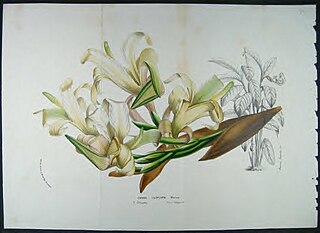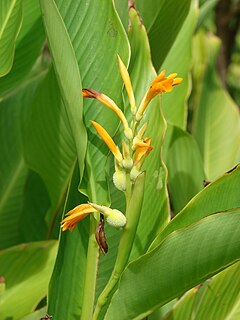
Canna or canna lily is the only genus of flowering plants in the family Cannaceae, consisting of 10 species. Cannas are not true lilies, but have been assigned by the APG II system of 2003 to the order Zingiberales in the monocot clade Commelinids, together with their closest relatives, the gingers, spiral gingers, bananas, arrowroots, heliconias, and birds of paradise.

Canna indica, commonly known as Indian shot, African arrowroot, edible canna, purple arrowroot, Sierra Leone arrowroot, is a plant species in the family Cannaceae. It is native to much of South America, Central America, the West Indies, and Mexico. It is also naturalized in the southeastern United States, and much of Europe, sub-Saharan Africa, Southeast Asia, and Oceania. Canna indica has been a minor food crop cultivated by indigenous peoples of the Americas for thousands of years.

Canna glauca is a species of the Canna genus, a member of the family Cannaceae. It is native to the wetlands of tropical America and was introduced to England in 1730. It is also reportedly naturalized in Sri Lanka, Thailand, Vietnam, Java and the Philippines.

Canna flaccida is a species of the Canna genus, a member of the family Cannaceae. The species is indigenous to the wetlands of the south-central and south-eastern United States from Texas to South Carolina. It is also reportedly naturalized in India, the Philippines, Mexico, Panama, Cuba, the Dominican Republic, Peru and southern Brazil.

Canna coccinea is a species of the Canna genus, belonging to the family Cannaceae. A native of northern Argentina., it was introduced in England from South America in 1731.

Canna compacta Roscoe is a species of the Canna genus, belonging to the family Cannaceae, distributed between the south of Brazil and northern Argentina. Introduced to England from South America in 1820. Not to be confused with C. compacta Bouché, which is a synonym of C. indica L.

Canna tuerckheimii is a species of the Canna genus, belonging to the family Cannaceae. Its specific epithet tuerckheimii commemorates Hans von Türckheim, a 19th-century German plant collector.

Canna iridiflora is a species of herb in the family Cannaceae.
Canna bangii is a species of herb in the family Cannaceae. It is native to Peru and Bolivia.

Canna liliiflora is a species of herb in the family Cannaceae. It is native of Peru and Bolivia.

Canna patens is a species of herb in the Cannaceae family.

Canna pedunculata is a species of the Canna genus, belonging to the family Cannaceae. Native of south-east Brazil at low altitudes. Johnson's Dictionary of 1856 reports that it first entered England in 1820, pedunculata meaning 'long-flower-stalked'.

Canna jaegeriana is a species of herb in the family Cannaceae.

Canna paniculata Ruiz & Pav. is a species of the Canna genus, belonging to the family Cannaceae. Native of southern Mexico, Costa Rica, and tropical South America, except for the Amazon Basin, at 200-2,000m (650-6,500 ft).

Canna speciosa (Roscoe) Hook. is a species of the Canna genus, belonging to the family Cannaceae, a native of the tropical Americas. Introduced to England from South America in 1820, speciosa meaning 'showy'..

Nobuyuki Tanaka is an economic botanist at the Tokyo Metropolitan University, the Makino Botanical Garden in Kōchi Prefecture, Japan.
Canna amabilis is a species of herb in the family Cannaceae. It is native to Northern Argentina.
The Canna Agriculture Group contains all of the varieties of Canna used in agriculture. Canna achira and Canna edulis are generic terms used in South America to describe the cannas that have been selectively bred for agricultural purposes, normally derived from C. discolor. It is grown especially for its edible rootstock from which starch is obtained, but the leaves and young seed are also edible, and achira was once a staple foodcrop in Peru and Ecuador.















